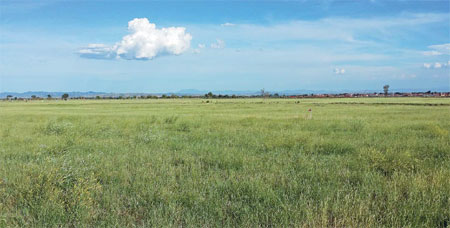Green mountain revitalized
Eco project boosts tourism and improves quality of life, Hao Nan and Yuan Hui report.
Blue skies dotted with white powder-puff clouds and fresh air carrying the scent of pine trees and wildflowers greet visitors to the Daqing Mountain range in Hohhot, capital of the Inner Mongolia autonomous region.
The Daqing Mountain literally means the Great Green Mountain, and also gives the city its name, which means the green city in Mongolia.
However, the mountain's name fell short of reality a decade ago and was nicknamed the "great gray mountain" by locals.
The lack of protective vegetation meant the mountainous area's ecological environment was left vulnerable and suffered frequent natural disasters such as droughts and sandstorms.
To improve the situation, the local government has tried every means to solve the problem of large unattractive looking sandy areas by planting more trees, building infrastructure and parks.
In 2012, the Hohhot government started a large-scale forestry and environmental protection project to revive the mountain's southern slope and transform the area into the city's "back garden".
Under the plan, the government pledged an 11 billion yuan ($1.7 billion) investment over three years to plant more than 10 million trees and build a 660-hectare pasture area.
The authority also invested 3.5 billion yuan for the city's ecological construction.
As of last year, the government had built four parks and landscaped 17 main streets.
The mountainous area's forestry coverage rate has reached 41 percent and the city's per capita green area hit more than 30 square meters, almost fourfold of the country's average.
In the coming two to three years, the project will focus on tree planting in villages as well as along the G6 Expressway and streets surrounding the southern slope of the mountain.
"The project was important to the city's ecological construction and helped to accelerate the development of the cultural tourism industry.
"I hope the project can also solve the production and living problems of the local villagers," said Nasanmunkh, Party chief of Hohhot.
Zhang Rui, Party chief of the Xincheng district, echoed his sentiment and said the government aimed to create a better living environment for villagers and allow them to enjoy different kinds of social securities.
Also, two fruit gardens and one botanical garden are due to be established.
The city government is also making efforts to create a tourist brand by advertising the mountain's natural resources and the grassland culture.
Yun Yuming, head of Xincheng district, said the project covering 18 villages aimed to integrate local ecological protection, modern agriculture and the tourist industry.
He said that more than 80 percent of the southern mountain's surface was to be covered by trees and other types of vegetation.
Horse racing
Louis Romanet, chairman of the Paris-based International Federation of Horseracing Authorities, once said the Inner Mongolia could be an ideal place to develop the horse racing industry.
The Hohhot government considers the industry a pillar of the local economy.
The authority is working on an international horsemanship and tourist center to combine modern management of horses with Mongolian culture.
The center will integrate horse breeding, riding and racing as well as other sports and entertainment activities, with a total investment of 68 million yuan.
It is also expected to be the host venue for celebrations that will mark the 70th anniversary of the establishment of the autonomous region in 2017.
Shengshuiliang Mountain
Nearly 50 kilometers away from the city's downtown, Shengshuiliang Mountain is famous for its clear springs at its peak. Villagers nearby use the water during sacrifices to their ancestors, which are held every year on May 13 of the lunar calendar, because, according to local legend the water has holy powers that can protect drinkers from illness and prolong their lives.
The mountain is surrounded by a picturesque five-square-km primeval forest in the north and a 15-square-km alpine grassland area in the south.
Several scenes from the TV series Genghis Khan were filmed in the area in 1996.
Central park
A large central park at the main range of the Daqing Mountains is under construction.
When complete, it is expected to be the city's new economic growth point and will host Chinese and overseas large-scale sports events.
A 100-km national mountaineering and fitness road in the park has been finished and was selected as one of China's 10 classic routes for sports tourism in 2013.
Xincheng District
The Xincheng district is one of the main districts of Hohhot. It has a population of more than 600,000 and covers an area of 700 square km.
The district is home to 33 ethnic groups, but the Manchu people are the majority.
About 10,000 Manchu people live in the district, one-third of the ethnic group's population in Hohhot. The district is the city's transportation hub, financial and sports center as well as an important gateway for the opening-up strategy.
|
The Daqing Mountain range in Hohhot, capital of the Inner Mongolia autonomous region, is renowned for its natural landscape and local culture. Liu Xingshuang / for China Daily |



 Print
Print Mail
Mail






